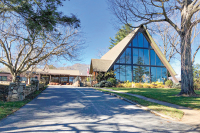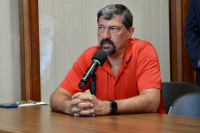Watershed assessment still underway
The team of experts conducting an ecological assessment of Waynesville’s 8,600-acre watershed has collected so much data that they have had to hunt down a bigger software package that can actually handle the load.
“We cannot fit this on Excel,” said Dr. Peter Bates, the director of Western Carolina University’s natural resource and conservation management program who is heading up the study of the watershed.
One of three creekside stations that collect data on water quality every five minutes has already generated more than half a million data points.
As overwhelming as that sounds, Bates said the data is “good to have” as he updated Waynesville town board members at a meeting last week. Waynesville conserved its giant watershed several years ago, protecting the town’s pristine drinking water supply. The town engaged Bates and his team to develop baseline data that will gauge both water quality and forest health over time.
While the former has been relatively straightforward, the latter has been difficult to define, according to Bates.
“It’s a little more fuzzy than water quality,” Bates said. “It’s ambiguous how you actually quantify in numerical terms what a healthy forest is. What we’re trying to do is create or increase natural diversity.”
Related Items
Bates said diversity is the key to healthy water, plants and animals.
According to him, cutting down white pine trees would actually help create that natural diversity, since those trees were never native to the watershed anyway. Waynesville residents planted them in the late 1800s and early 1900s to stabilize the soil after they started harvesting the land.
Now, the white pines are more harmful than helpful to the watershed, according to Bates.
“White pines are shading other trees out, keeping them from coming in,” Bates said. White pine themselves are stagnating because they were planted close together and compete for sunshine.
If these trees are cut down, the end result would be more sunlight, moisture and all-around vigor for native plants and the forest floor.
When Waynesville placed the watershed in a conservation agreement several years ago, town leaders reserved the right to cut trees on the property rather than create an untouchable lockbox.
The prospect of future logging has caused controversy in the past, but as leaders promised at the time, it won’t be happening any time soon. Waynesville officials are being deliberate and gathering as much public opinion as well as scientific data as possible before making any decisions.
“The trees aren’t going to be cut for a long time,” Bates said.
Bates said he’d like to see more yellow poplars, oaks and ash trees in the watershed, as well open savannah-like pine forests reestablished along the ridges.
In the meantime, the team studying the watershed will continue working toward a complete forest inventory to keep track of any changes in forest conditions over time.
The team has also observed that some culverts and improperly graded gravel roads were causing impure water to be channeled into the stream. The team has accordingly begun a study of every road-stream intersection in the watershed.









